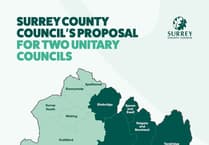Faced with impossible top-down housing targets, the threat of severe penalties and no control over developers, councils face an endless blame game that often leads to speculative development on green fields.
In this article, LIZ TOWNSEND BEM, the Lib Dem councillor for Cranleigh East and portfolio holder for planning at Waverley Borough Council, reveals Waverley’s strategy to challenge unrealistic and unattainable government housing targets and learn from past mistakes...
Trying to explain national planning policy is difficult because there’s no escaping the fact it’s complicated, and the government are often moving the goal posts. So complaints about the council, without acknowledging the role of government in planning, could be perceived as simply political manoeuvrings.
This blame game is never-ending for councils, as the imposed top-down targets for housing delivery are used as a stick to beat us, while the government takes a back seat, giving contradictory directions and every so often grabbing the wheel when it suits them.
The government says it wants a ‘plan-led’ system delivered by local planning authorities – but imposes binding housing targets and penalties when these are not met. There appears to be no recognition that there are three parties in this relationship – the government, the local planning authority, and the developers: and the developers are not bound by any targets so they can do as they please, sometimes leaving the council and our residents in very difficult situations.
Holding developers to account
Councils have long campaigned for government to provide tools to hold developers to account for delivering housing on approved development sites on time. There are some signs in the recently-proposed national planning reforms that these requests may have been recognised (or perhaps it’s the looming general election), and after many years the government is finally at least acknowledging this is an issue.
Whether these initial suggestions make their way through to the final draft is yet to be seen and may only see the light of day after the election, and they’re toothless until adopted.
Currently, the responsibility for delivering housing is placed entirely on local planning authorities. However, once planning permission is granted, the council has literally no control at all of whether or not sites are built out.
The government’s system tests councils’ housing delivery against their annual targets, with any backlogs added on to targets for following years. This is simply punishing councils and the communities they represent, for developers’ failure to deliver new homes.
Set up to fail
In addition to this annual test, councils must demonstrate there is sufficient housing coming forward in the five-year pipeline (five-year housing land supply) plus a five per cent buffer.
If a council ever gets into the position where it is reliant on a large site to deliver over a number of years, like Dunsfold Garden Village for example, and this gets delayed for any reason (spoiler: they always get delayed), this can put a significant hole in the projected pipeline figures. Then the government penalties really kick in for local communities that don’t have protection such as Green Belt or Areas of Outstanding Natural Beauty. The net result is more speculative development, usually on green fields.
This is known as the ‘tilted balance’ which favours an application when the council cannot prove a five-year supply of housing.
Tilting at windmills
This policy appears to create a perverse incentive for developers not to build out sites too quickly and therefore make it harder for the council to demonstrate a five-year land supply. Developers are also often able to engage the might of expensive legal teams to fight appeals on sites the council has already refused, by attacking the council’s projected figures and arguing they are not deliverable.
This ‘tilted balance’ is the reason we continually face a number of speculative appeals, and not the fact the council is legally required to review its Local Plan every five years, as some have mistakenly assumed.
Once the tilted balance is engaged, any policies in Local Plans are considered out of date and this includes policies within any Neighbourhood Plans that are more than two years old. This carries a huge risk from speculative development to areas of the borough on countryside beyond the Green Belt which, of course, seldom have reasonable supporting infrastructure.
And there are absolutely no guarantees that any speculative development that is granted planning permission will be built, creating an ever-increasing spiral of permissions being granted, perhaps to the same developer who has a site down the road that is not delivering new homes.
The incentive is entirely tilted in favour of private developers who limit housing coming on to the local market, keeping house prices high and generating soaring profits.
Unaffordable homes
A further issue that compounds Waverley’s problems is we have among the highest property prices outside of London. The government naively thinks it can simply increase our housing targets to force us to build our way to lower house prices. So while they load up to 90 per cent on our housing need figure to address what they refer to as affordability issues, they have done nothing to give us the power to actually get developers to build new homes.
There is also considerable criticism from councils that the government is using outdated household forming projections data from 2014, instead of the 2021 census data, which shows that in recent years, there has been a significant reduction in new households forming across the country. However, the government is refusing to introduce this new data until after 2024 – presumably again the looming election is a factor in this.
Learning from mistakes
Against this complex backdrop, Waverley is at a great disadvantage. What is clear however, is that the government gives greater protection to councils that adhere to a plan-led approach. Furthermore, we have learnt from the mistakes of the past administration, and do not intend to simply accept higher government housing targets without challenge and without evidence. This would see our annual housing target increase from 590 new dwellings to an unrealistic and unattainable 742 per year.
Neither will we proceed with an un-evidenced figure and see our plan immediately thrown out by an inspector on examination, as happened in 2013, leaving the borough wide open to speculative development for five long years until Local Plan Part One was adopted in February 2018.
Nor the final avoidable mistake later in 2018 when the second part of the plan was withdrawn without notice, leaving the council again in a far from robust position.
A legal requirement
We have a legal requirement to review our plan when it is five years old, and the first part of our plan has reached this stage. We have gone through a thorough review process, as recommended by government, and this has clearly demonstrated the plan needs updating. This is an opportunity to finally regain some control over housing delivery across the borough. It would be wrong to pretend this update process, rather than the ‘tilted balance’, is causing the current speculative development we are seeing in places like Farnham, Cranleigh and Alfold.


.jpeg?width=209&height=140&crop=209:145,smart&quality=75)


Comments
This article has no comments yet. Be the first to leave a comment.